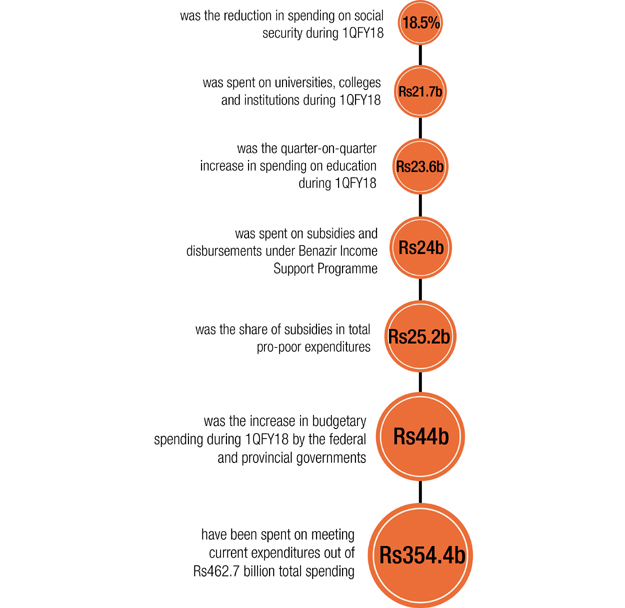
The Poverty Reduction Strategy Report (PRSP) for the first quarter of fiscal year 2017-18 showed that the federal and four provincial governments spent Rs462.7 billion, up 10.4% or Rs44 billion compared with the expenditures made in the first quarter of previous fiscal year.
However, a huge sum of Rs354.4 billion was spent on meeting current expenditures including salary payments and other recurrent obligations.
Islamic finance has potential to end poverty worldwide
The finance ministry traces spending patterns in areas like road building, environment protection, education, health care, agriculture, rural development, law and order, justice administration and subsidies. Expenditures on all these heads are clubbed as poverty reduction expenses.
The five governments spent Rs25.2 billion on paying subsidies in the first quarter, up 30.7%. Subsidies had a share of only 5.4% in total pro-poor expenditures.
An amount of Rs24 billion was spent on targeted subsidies and cash disbursements under the Benazir Income Support Programme (BISP).
Despite the increase in overall pro-poor spending by the federal and provincial governments, there is no significant change on the ground, say social-sector experts. There has been a constant increase in inequality and poverty and the government seems reluctant to come up with the exact number of people living in poverty.
On social security and welfare, Rs7.9 billion was spent against Rs9.7 billion in the comparative period of previous year. Expenditures on social security fell 18.5% largely because of low spending by the Sindh government.

CREATIVE COMMONS
One of the reasons behind the low impact is that most of the expenditures that are counted as pro-poor are actually made to pay salaries to the departmental staff, particularly in the areas of health, education, justice administration and law and order.
Overall, the federal and provincial governments spent Rs160.64 billion on education, Rs23.6 billion or 17.2% higher than the previous fiscal year. But 92.5% of this went to current expenditures. The share of education spending in total pro-poor expenses went up to 34.7% from the previous year’s 32.7%.
Spending on universities, colleges and institutions increased to Rs21.7 billion due to higher federal spending on higher education. The spending on higher education by the provinces remained almost at the previous year’s level.
Health spending came in at Rs57.8 billion, an increase of Rs13.1 billion or 29.3% from the same quarter of previous year. Of this, Rs49.2 billion was on account of current expenditures, mostly for salaries and transportation.
The share of health spending in total pro-poor expenditures was 12.5% in the first quarter, up from 10.7%.
There have been concerns about deterioration in the social indicators of health and education despite pumping an additional hundreds of billions of rupees into provinces under the seventh National Finance Commission Award.
40% Pakistanis live in poverty
There are now proposals to create a link between the improvement in social indicators and additional transfer of financial resources to the provinces.
The government spent roughly Rs82 billion on maintaining law and order, up Rs11.5 billion or 16.3% from last year. Almost the entire amount was spent on running expenses. The increase was across the board. The share of spending on law and order in total expenditures inched up to 17.7%.
On the administration of justice, Rs9.6 billion was spent compared with Rs7.9 billion a year ago.
The spending on agriculture went down 6.8% to Rs34.6 billion. Similarly, expenses on building highways fell 18.6% to Rs44.5 billion in the first quarter of current fiscal year.
The reduction was mainly because of low spending on building roads and highways by the Punjab government. The provincial government spent Rs14.4 billion on roads in the first quarter, down 28.4%.
Published in The Express Tribune, January 5th, 2018.
Like Business on Facebook, follow @TribuneBiz on Twitter to stay informed and join in the conversation.









1732486769-0/image-(8)1732486769-0-270x192.webp)







COMMENTS (3)
Comments are moderated and generally will be posted if they are on-topic and not abusive.
For more information, please see our Comments FAQ